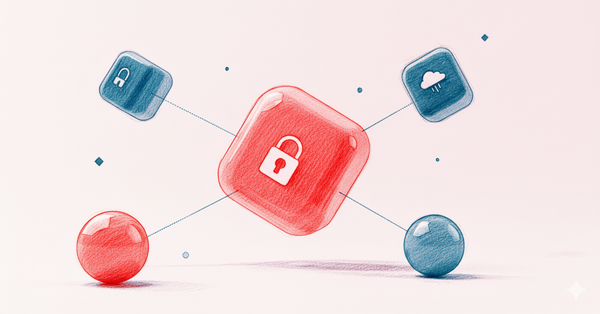AI marketing automation: Your new superpower isn't a prompt, it's a system

This article doesn’t just discuss AI marketing automation; it was built with it.
The article you are reading is the output of a coordinated system of specialized n8n workflows. It began with a core topic, which was passed through a series of AI agents, each with a distinct function:
- Context & strategy: The initial workflow queried a Pinecone Vector Database of our entire content library (RAG) to identify semantic gaps, formulate a structural strategy, and discover opportunities for internal linking.
- Blueprint generation: The strategic insights were then compiled into a structured JSON blueprint, containing SEO and GEO metadata, a hierarchical outline, key entities, and a target keyword strategy.
- Content rendering: Following human review and approval of the blueprint, a final agent ingested the JSON payload and rendered it into this full-length article, optimized for discoverability by both Search Engines and Large Language Models (LLMs).
This demonstrates a fundamental paradigm shift. The future isn't in writing isolated prompts; it's in engineering intelligent, interconnected systems that automate and scale entire marketing functions.

Powered by flexible tools like n8n, it gives marketers the ability to move beyond one-off tasks and build automated engines that think, connect, and act.
The manual AI trap: Why your ChatGPT prompts don't scale
Using LLM Chatbots like Chat GPT or Gemini for daily tasks is a fantastic starting point. You can brainstorm ideas, write a social post, or summarize a transcript.
However, standard chat-based LLM interfaces have critical limitations for executing automated, real-world tasks:
- The manual bottleneck: Chat interfaces aren't built for automated bulk data processing. Manually feeding large datasets into a prompt is an inefficient exercise that breaks at scale.
- Context blindness: The AI has no access to your real-time campaign data, your product inventory, or your customer database. It gives you generic advice because it doesn’t know what’s actually happening in your business.
- Operating in a vacuum: The output of a prompt is just text. It doesn't do anything. You still have to take that ad copy, navigate to your ads platform, create a new ad, and paste it in. The insight is disconnected from the action.
The real game-changer: From manual prompts to automated engines
Here’s a simple metaphor: Manual AI is like having a brilliant consultant who can only talk to you. An automated AI system is like putting that consultant in charge of an entire AI Agent team.
The objective is to architect a team of AI marketing agents that execute both routine and complex tasks, freeing up your team and generating actionable insights at scale.
We do this by connecting three distinct layers with an AI workflow automation builder. That’s where a tool like n8n comes in. It’s the platform that allows you to connect these layers without writing (complex) code, creating a seamless engine.
You can find the fundamentals of this software in detail in our guide n8n foundations: a marketers guide to AI Workflow Automation.
Layer 1: The API backbone (connecting your stack)
This is the data layer. APIs (Application Programming Interfaces) are the pipes that allow your (marketing) tools like Google Ads, Facebook Ads, your CRM, Google Analytics, BigQuery, Slack, Google Docs, Gmail, Google Calendar to talk to each other. This backbone gives your system access to the raw materials it needs to work with.
Layer 2: the AI brain (your specialist AI Agent)
This is the intelligence layer. At its heart, the agent's brain is a powerful Large Language Model (LLM). Think of this LLM as a brilliant but general-purpose engine. To perform a specialized task, it needs two key inputs:
- Instruction: This is the direct, specific command you give it, such as "classify the intent of this search term" or "score this new lead."
- Context: This is the crucial background knowledge that makes the instruction meaningful. Using techniques like Retrieval-Augmented Generation (RAG), the agent pulls relevant information from your unique data sources (like product docs, past tickets, or company policies) before it acts.
By combining your specific instruction with the right context, the LLM is transformed from a generic tool into a specialist AI agent that can execute your business tasks with high accuracy.
Layer 3: The automated action
This is the execution layer. Based on the AI's output, the workflow takes immediate, automated action. If the AI brain scores a lead as "highly qualified," this layer automatically sends a Slack alert to the sales team. If it classifies a search term as irrelevant, it automatically adds it to a negative keyword list in Google Ads.
Building with LEGOs: Modular & chainable workflows
The real power emerges when you realize these automated engines aren't monolithic systems. They are built from small, specialized, and reusable workflows that can be chained together like LEGOs.
Imagine you build one central, highly-specialized workflow: the AI Data Collection Agent.
Its only job is to take a natural language question (e.g., "What was our cost per lead last week?"), translate it into a perfect SQL query, run it against your BigQuery database, and return a clean data object.
This agent is your reusable LEGO block. Now, other simple workflows can call it to perform entirely different jobs:
- The weekly report agent: This workflow runs on a schedule. It calls the AI Data Agent three times with three different questions to get data on spend, CPA, and conversions. It then takes the three clean data outputs and formats them into a summary for a weekly performance email.
- The anomaly detection agent: This workflow runs every hour. It calls the AI Data Agent with one question: "What is the Advertising Spend in Facebook for the last hour?" It then checks if the result is 20% above the benchmark. If so, it sends an urgent alert to a Slack channel.
- The presentation builder agent: This workflow is triggered manually. It calls the AI Data Agent to get performance data for the last 30 days, then uses the structured data to automatically populate a Google Slides presentation template for a monthly business review. The user can have a back-and-forth conversation with the AI Agent to fine-tune the design and content of the slides.
This multi-workflow approach is superior because complex logics (e.g. turning language into SQL) are built and maintained in only one place. The application workflows (e.g. building Presentations with data) stay simple, clean, and focused on their specific output.
A modular setup also makes debugging easier and allows for precise, targeted improvements.
n8n Foundations: A Marketer's Guide to AI Workflow Automation
Your new superpowers unlocked
This systemic approach unlocks capabilities that are impossible with manual prompting.
Superpower #1: Infinite scale & intelligence
- Before: You spend hours manually spot-checking 1000s of new search terms in Google Ads, trying to find winners and losers.
- After: An n8n system automatically pulls all new search terms every single day. It sends each one to an AI agent that classifies it by user intent (Informational, Commercial, Transactional), product fit, and type (Branded, Competitor, Generic). The system then compiles a report with actionable recommendations and sends it to you.
Superpower #2: Context-aware intelligence
- Before: You ask ChatGPT for "ad copy for running shoes." It gives you generic, uninspired options.
- After: An n8n workflow feeds an AI agent your official brand voice guidelines, your target audience personas, and a real-time feed of your product inventory. The prompt becomes: "Generate three ad headlines for the 'Model X Pro' running shoe, which is currently in stock, targeting our 'Competitive Runner' persona, and adhering to the attached brand voice." The output is on-brand, relevant, and immediately useful.
Superpower #3: From insight to action in milliseconds
- Before: An analyst notices a campaign is overspending and performing poorly. They put the insight in a weekly report. By the time a manager sees it and takes action, a week of budget has been wasted.
- After: The system identifies a CPA anomaly in real-time. A workflow automatically pauses the poor-performing ad group and reallocates its daily budget to a top-performing one, all within seconds. The insight and the action are one and the same.
The strategic shift: From task-doer to systems architect
AI Marketing Automation fundamentally changes your role from a doer of tasks to an architect of systems. You stop being the person who manually pulls the levers and become the person who designs the machine that pulls the levers for you.
You are the AI team owner, not just the architect
This is the final, most empowering point. Tools like n8n give you full control to build and customize the AI "Team." You aren't leasing a black-box solution; you own the means of production.
As one person, you now have the power to build an army of AI agents. You can create hundreds of specialized n8n workflows, each a master of its domain, that all work together. You are literally building a custom workforce of AI agents that will operate 24/7, executing your strategic vision at a scale and speed that was previously unimaginable.
The choice is becoming clear. Manual AI makes you a faster task-doer. AI Marketing Automation turns you into the owner of an intelligent marketing AI team.
Frequently Asked Questions (FAQ)
Do I need to be a developer to build these AI automation systems?
No. This is the most significant shift. N8n is "low-code," meaning they use a visual, drag-and-drop interface. While some basic technical concepts are helpful, the goal is to empower marketers and operators, not just developers, to build powerful systems. You're connecting nodes, not writing lines of code.
Why build a custom system in n8n instead of using an all-in-one AI tool?
Control, cost, and customization. All-in-one tools are often "black boxes" that lock you into their way of doing things and can become expensive. Building with n8n gives you full ownership. You can connect any tool you want, design the exact logic your business needs, and host it yourself, which dramatically reduces costs at scale.
What does it cost to run an AI marketing automation system?
The cost has three main components:
- n8n hosting: You can start for free on their cloud plan or self-host for minimal server costs.
- LLM/AI Model Usage: You pay for what you use via API calls to models like OpenAI's GPT or Anthropic's Claude. These costs are typically very low on a per-task basis.
- Your time: This is the biggest investment upfront, but it pays dividends as your automated systems save you hundreds of hours in the long run.
What's a good first project for AI marketing automation?
Start with a high-volume, low-complexity task that involves data classification. The "Google Ads Search Term Classifier" mentioned in this article is a perfect example. It provides immediate value by saving hours of manual work, is relatively simple to build, and clearly demonstrates the power of connecting an API (Google Ads) to an AI brain (an LLM).






